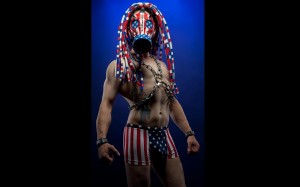Psychosexual dysfunctions in the USA
During the 1960s, America experienced a dramatic shift in traditional values related to psychological views on sexuality. With profound societal change occurring with the Civil rights movement and the baby boom generation, the first modern era of open sexuality in America challenged established sexual norms. The height of the sexual revolution was accompanied by massive physiological and psychological breakthroughs: The advent of the birth control pill shook the traditional expectations and understanding of female sexuality. Coinciding with the sexual revolution was renewed focus in psychology dedicated towards sexuality in America, typified by the works of Alfred Kinsey, William Masters, Virginia Johnson among many others. Yet, the story of sexuality and psychosexual dysfunctions in America is not without its challenges, particularly when socioeconomic circumstances are focused on.

A study in 2008 by the Alan Guttmacher Institute, a reproductive health and rights think-tank, reported that 1.2 million abortions occur in America every year. This public health and moral dilemma is only recently being understood from the context of poverty, ethnicity, the inadequacy of current health services, and, most importantly, the psychological impact of all these factors. The patterns in the socioeconomic characteristics of women obtaining abortions are undeniable: the Centers for Disease Control and Prevention reports abortion rates among women living below the federal poverty level are more than four times that of women above 300% of the poverty level. But, exactly what do such public health issues say about the psychosexual and psychological health of Americans and corresponding psychosexual dysfunctions?
Psychosexual dysfunctions are defined as disturbances of sexual functioning that may be caused by mental and emotional difficulties. Unlike in many other developing countries, the American psychology community was at the forefront in research of the causes of psychosexual dysfunctions. The difficulty in assigning meaning to sexual dysfunctions such as impotence or non-existing libido is that they may be physiological in origin, such as from lack of exercise or poor diet. Indeed, Jimmy Dean’s Sausage on a Stick wrapped with a Chocolate Chip Pancake can have a psychosexual in addition to a physical toll on the body. But these sexual disorders in male and women commonly originate in the psychological. Feelings of guilt, stress, insecurities, anxieties, any troubling emotion to mental health, or childhood abuse can contribute to the development of psychosexual dysfunctions.
American research has long understood the mental aspect of sexual dysfunctions and dealt with it more effectively than any other country’s psychological investigations. While Sigmund Freud’s psychoanalysis therapy initially influenced American sexual therapy, the studies of the likes of Alfred Kinsey, Joseph Wolpe, and Arnold Lazarus all contributed in spotlighting human sexuality as a subject of scientific investigation and an issue of psychiatry and medicine. This was unprecedented. Introduced by William Masters and Virginia Johnson, American psychotherapy introduced the behavioral therapy model by viewing psychosexual dysfunctions as the result of learned responses that can be modified through communication, mutual responsibility in both sex partners, reduction of anxiety, and a shift in attitude and lifestyle. This was unprecedented. Other forms of psychotherapy, such as cognitive, gestalt, and imagery therapies, all became practiced in America as there was an undisputed link between social anxieties, psychosexual disorders, and the need for sexology research to deal effectively with these problems.
While America experienced a Sexual Revolution that changed the sexual behavior of Americans, it was an incomplete and disingenuous revolution. It embraced excess and universality, rather than viewing sexual behaviors in the context of society and culture – particularly the socioeconomic realities of America. This self-deception parallels the archetypical American story with its patriotic hymn of equality and freedom of opportunity as the cornerstones of American society. This ‘can-do’ mentality is admirable in many respects, but regarding psychosexual health it is misguided. The Sexual Revolution and all its breakthroughs often ignored the influence of sexual socialization from families, media, or peer groups in psychosexual dysfunctions. It ignored psychosexual health’s dependence on the perspectives of cultural norms. It is not much of a coincidence that higher rates of depression, the psychosexual dysfunctions that arise from this mental disorder, and abortion rates are most prevalent in lower socioeconomic Americans. In some form, they all influence one another.
Despite the depth of understand concerning psychosexual dysfunctions in the American medical community, its naïveté in ignoring economic, cultural, and social influences has not only undermined the effectiveness of this knowledge, but allowed it to be challenged. Increasingly, American religious institutions on the national and community level identify proponents of loosened sexual norms as representing the interests of those who want to devalue morality in America. The traditionalist Intercollegiate Studies Institute even rates Alfred Kinsey’s Sexual Behavior in the Human Male as the fourth most harmful book of the 20th century. Fundamentalist and evangelical Christian factions stress sexuality to be between married couples. Suffering from psychosexual dysfunctions, such as impotence or lack of sexual arousal, in non-married couples may be a result of disobeying natural law.
[ad#downcont]Sexuality in America is full of contradictions. It is open in many respects, but is viewed disdainfully in others. Popular American culture promotes universal psychosexual health transcending socioeconomic differences, yet trends of public health problems suggest that the importance of income, community expectations, and ethnicity are often underestimated. With these contradictions comes the stress of being a sexual American. And with this stress attached to sexuality, psychosexual dysfunctions appear. Though American psychology seems to have found most of the answers concerning psychosexual dysfunctions with their innovative therapies and medication, it appears that they have often misunderstood the questions needing to be asked.
